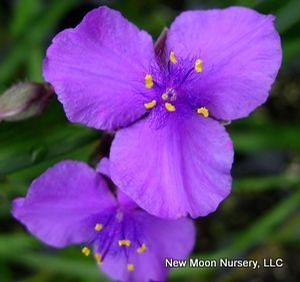New Moon Nurseries
Tradescantia virginiana
Spider lily
Native to North America
FIRST IMPRESSIONS: Tradescantia virginiana is a robust perennial with multiple stems bearing narrow pointed olive green leaves. In late spring, foliage is topped by small clusters of violet florets. This charming wildflower thrives in open woods or in partly sunny gardens with average soil.
HABITAT & HARDINESS: Tradescantia ohiensisis is native from Maine to Georgia and west to Minnesota and Louisiana.
This spiderwort is indigenous to Blackland prairies, sand prairies, thickets, edges of rocky open woods, sandstone cliffs, limestone outcrops, meadows and woodland right of ways. This species usually occurs with trees and shrub-like plants.
Plants are hardy in USDA Zones 4-9.
PLANT DESCRIPTION: Tradescantia virginiana grows in unbranched clumps that originate from thick fleshy roots and rhizomes.
Stems are green and smooth and foliage is entire with pointed tips. The narrow blades are up to 12” long and 1” across with basal sheathes that wrap around the stems. The blades have parallel veins and tend to droop toward the tip.
For about six weeks in late spring and early summer plants bear small tightly clustered terminal cymes. The 1” florets are violet to blue or occasionally pink or white. Each consists of three rounded petals and six bright yellow anthers supported by feathery violet filaments.
The lovely blooms are ephemeral – opening for only a day and only in the morning. The florets close during bright sunny afternoons and a new crop appears the next day.
After flowering, seed capsules split into 3 segments releasing small brown seed.
Plants are up to 2.5’ tall with a 1-2’ spread.
CULTURAL & MAINTENANCE NEEDS: Tradescantia virginiana grows best in partly sunny sites with moist acidic well drained soil.
This versatile wildflower prospers in average garden soil or in moist or dry loamy, clay, gravelly or sandy sites. Plants also tolerates alkaline soils, drought and sunny or lightly shaded exposures.
Plants are fairly pest resistant but are occasionally nibbled by deer.
In good garden soils, this spiderwort can spread and seed aggressively. Deadheading spent flowers can stimulate re-bloom and prevent unwanted seedlings.
In warm regions, spiderworts go dormant during the summer. In gardens it is wise to pair them with late blooming perennials that can fill the gaps.
LANDSCAPE USES: Tradescantia virginiana is appropriate for Perennial Borders, Shade Gardens or Rock Gardens. Small Groups or Masses of plants offer Attractive Foliage, Showy Flowers and Erosion Control. This species is a valuable component of Cottage Gardens, Low Maintenance Plantings, Meadows and Wildlife Gardens.
COMPANION & UNDERSTUDY PLANTS: Tradescantia virginiana mingles cheerfully with Chrysogonum virginianum, Penstemon digitalis, Rudbeckia hirta and Schizachyrium scoparium.
Tradescantia ohiensis is similar in appearance and culture and could be substituted in some situations.
TRIVIA: Flowers are pollinated by bumblebees. Other bees, flies and butterflies also visit the flowers. Deer, Rabbits, Turtles, and some livestock nibble the foliage.
Tradescantia virginiana was recognized as the Virginia Native Plant Society’s 2008 Wildflower of the Year.
Compared to look-alike species, Tradescantia virginiana has narrower blades, smoother sepals and no glaucous leaf and stem surfaces. T. ohiensis has glabrous flower stalks and sepals and waxy glaucous stems & leaves. T. subaspera, has blades wider than its own leaf sheathes and broader than the other two species. These three readily cross and the resulting hybrids are referred to as T. x andersoniana
Height:
2-3 ftSpread:
1-2 ftSpacing:
18-24 inUSDA Hardiness Zone:
4-9Bloom Color:
LavenderTradescantia virginiana Characteristics
Attracts Wildlife
- Hummingbirds
- Butterflies
Attributes
- Favorite
- East-Coast Native
- Cut Flower
- Clay Soil
- Rock Garden
- Naturalizing
- Long Blooming
Exposure
- Full Sun to Partial Shade
Flowering Months
- July
- June
- May
Foliage Color
- Green
Growth Rate
- Fast
Juglans nigra Tolerance (Black Walnut)
- Yes
Season of Interest (Foliage)
- Fall
- Summer
- Spring
Soil Moisture Preference
- Moist
Interesting Notes:
For more information on this plant, visit the USDA PLANTS Database: http://plants.usda.gov/java/profile?symbol=TRVI
